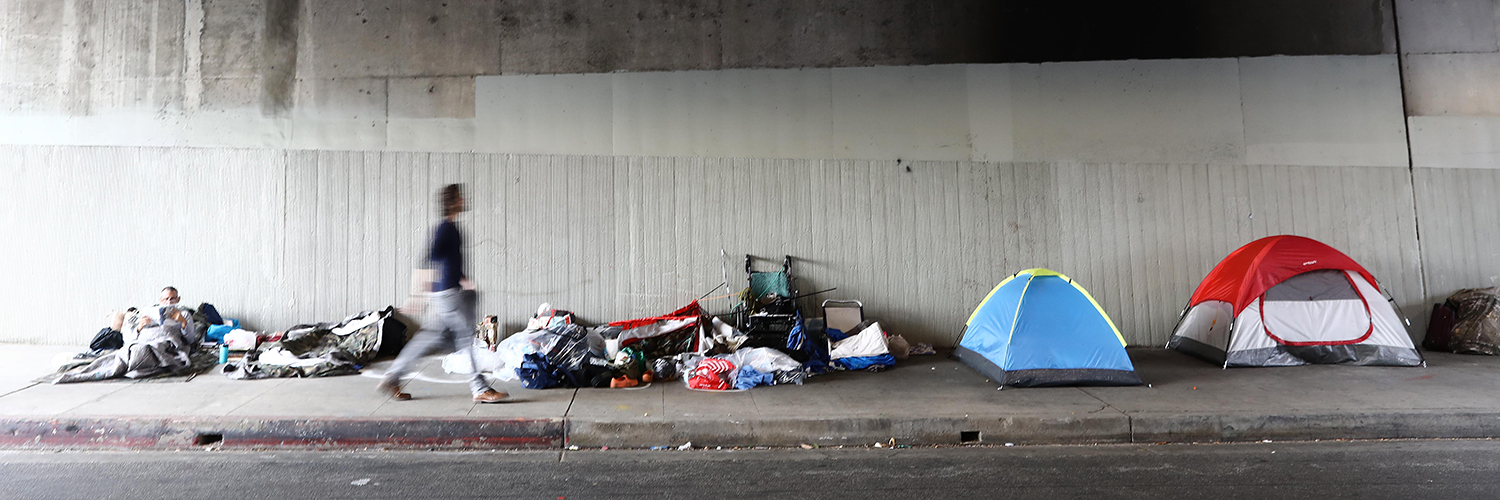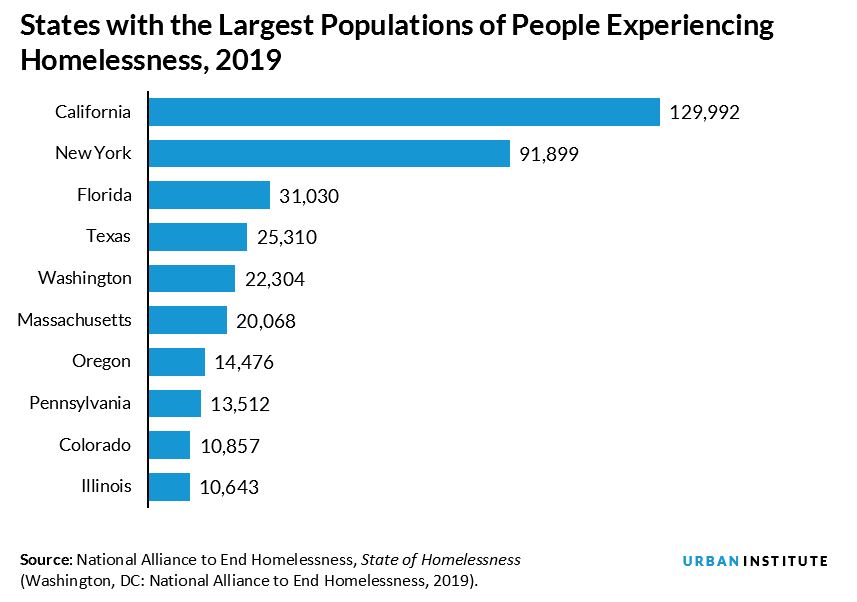
Photo by Mario Tama/Getty Images
The Trump administration has recently focused on the issue of homelessness, particularly in major California cities, while stating that the problem results from “liberal policies” in these areas.
A recent report (PDF) issued by the White House proposes using law enforcement as a “tool,” suggesting criminalizing homelessness, removing people from encampments, and relocating them. The report also calls for “deregulating” local housing markets but doesn’t offer many specifics.
The administration’s statements depict homelessness as a new, major problem unique to certain cities and their political cultures. But as the report notes, homelessness is fundamentally a housing problem. And no place in the country—with liberal or conservative leaders—has enough housing for people at the lowest end of the income ladder.
Homelessness crosses political lines
California is grappling with an enormous crisis, but it is not the only state struggling with increased rates of homelessness. According to data highlighted in the 2019 State of Homelessness report, the 10 states with the highest homeless counts account for 55 percent of the homeless population:

Twelve states and DC have experienced an increase in homelessness since 2007, when data were first available to track the problem. States with increases in homelessness include both red and blue states (based on the results of the 2018 midterm election).

Is homelessness a bigger problem now? In many places, it’s more visible
In 2018 (PDF), about 553,000 people were experiencing homelessness in the United States. That number represents a 15 percent decline since 2007.
But since 2017, there has been an increase in those living unsheltered by about 2 percent. Recent counts have found nearly 200,000 people living unsheltered across the country, making homelessness more visible.
People living unsheltered tend to be concentrated in cities with booming economies and skyrocketing rents, but the problem is not limited (PDF) to these locations. Homelessness counts often underestimate numbers, particularly in rural areas, where homelessness remains a hidden problem.
Deregulation is not the answer to homelessness, but regulatory reform can help
The administration’s report claims that deregulation will decrease homelessness across the country—by as much as 55 percent in San Francisco, 40 percent in Los Angeles, and 36 percent in DC. But it also says that deregulation may take a long time to work, without specifying how long. It also doesn’t specify what constitutes “deregulation.” The models in the report that produce these estimates do not provide enough information to evaluate the rigor and feasibility of these claims.
Not all regulations are created equal, and we need more data on the impact of different regulatory reforms. Some land-use and zoning reforms are indeed needed to help clear the path to produce more apartments. Local policymakers have put in place land-use and zoning regulations that make it illegal to build higher-density multifamily housing.
In recent years, there has been a lot of debate on this issue, along with proposed bills and efforts to deregulate. They have been, at different times, met with fierce opposition from just about everyone—advocates for low-income people, environmental activists, and homeowners.
But even if these reforms occurred, it would not solve the homelessness crisis. Increased housing supply could help moderate rent prices, maybe enough to make some units accessible to lower incomes and stretch subsidy dollars further, but not enough for the lowest-income households. Even in an unconstrained market, building affordable housing does not pencil out. As a result of this market failure, providing adequate, affordable housing for the poorest people requires government intervention.
Criminalizing homelessness won’t work
Cities across the country, including those in California, still conduct sweeps, bans, and cite people for sleeping outside. This practice is actually on (PDF) the rise.
But criminalizing homelessness to force people into shelters is a bad idea. These actions traumatize people living in encampments and have negative implications for public health. They also don’t work; people experiencing homelessness may simply relocate to avoid them, or expensive jails or hospitals become de facto affordable housing.
Research shows (PDF) that criminalizing homelessness increases costs and strain on police, jails, and prisons—placing a heavy toll on state and local budgets. Courts (PDF) have also ruled these actions illegal, a ruling the Los Angeles Board of Supervisors has just signed on to appeal.
What does work?
Affordable housing
In the real estate market, it’s all about location, location, location. For solving homelessness, it’s affordable housing, affordable housing, affordable housing. According to the US Department of Housing and Urban Development (PDF), 8.3 million people across the US have “worst case housing needs.” But for years, federal, state, and local governments have ignored the need for building more affordable housing. More affordable housing requires the 3 p’s:
-
preserving the affordable housing we already have
-
producing more affordable housing
-
protecting tenants from abuse and an unregulated market
Policymakers on both sides of the aisle have underinvested in housing assistance, despite clear market failures and evidence that shows how housing stability affects outcomes for children and adults (PDF).
“Housing plus” services
About 24 percent of individuals experiencing homeless do so long term, or “chronically,” often suffering with mental illness or substance use disorders. The George W. Bush administration elevated a solution for chronic homelessness called Housing First, which reduces barriers to housing, such as sobriety or work requirements, and then combines supportive services with rent subsidies.
The Obama administration continued this approach, made significant investments in supportive housing, rapid rehousing, and prevention and prioritized resources toward people experiencing chronic homelessness and veterans. According to HUD’s Annual Homelessness Assessment Report, since 2007, chronic homelessness has declined by 26 percent, and since 2009, homelessness among veterans has decreased by 48 percent. Only recently, after years of decline, progress has stalled.
We can all accept blame for the current crisis
Homelessness may be ruining the “prestige” of our greatest cities as the president said, but not because people are sleeping on the streets, in doorways, and under bridges. It’s because we have failed to respond humanely—and to act based on evidence.
Today’s debate on homelessness looks like finger-pointing. The federal government blames California and vice versa.
Unfortunately, there’s plenty of blame to go around. Local jurisdictions across the country should pass laws to allow for more apartments and affordable housing production. The federal government should provide housing subsidies for people left out of the housing market.
But we shouldn’t place all the blame on the government. Many citizens have decided to push back on development of housing and homeless shelters in their own backyards. Homelessness is a symptom of our failed policies, collective choices, and the lack of political will to stop pointing fingers and invest in what the evidence says works—housing.
Let’s build a future where everyone, everywhere has the opportunity and power to thrive
Urban is more determined than ever to partner with changemakers to unlock opportunities that give people across the country a fair shot at reaching their fullest potential. Invest in Urban to power this type of work.